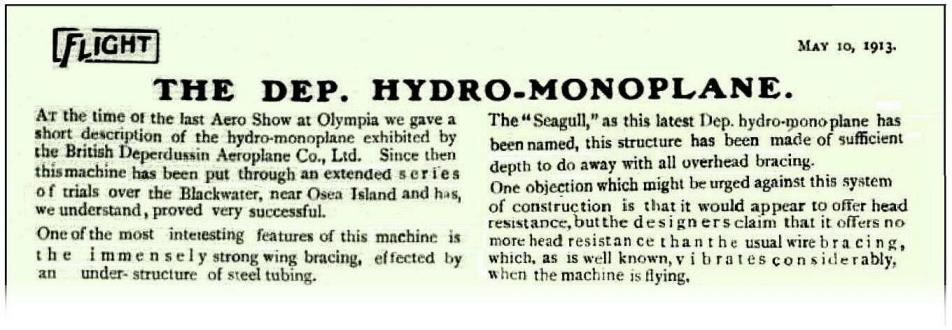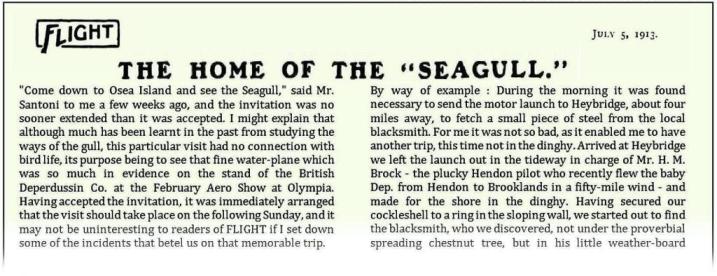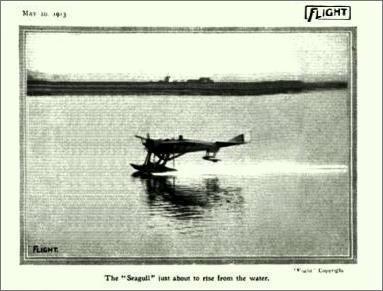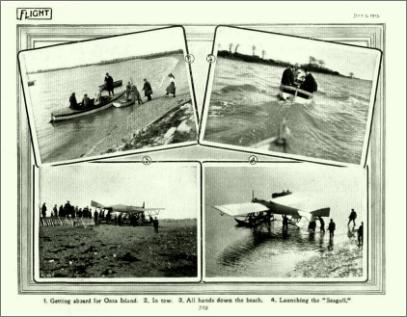|
Osea Island Seaplane Trials with Commander John Porte’s invovlement |
|||
|
In
1913 Osea Island was enveloped in tight security when the Royal Navy
conducted a series of tests on a revolutionary new two-man Seaplane called Seagull which was intended to be the
main line of defence against enemy submarines and Zeppelins. The British
Deperdussin Aeroplane Company demonstrated the seaplane in the Blackwater
Estuary around Osea Island. The aeroplane was a single engine monoplane with
revolutionary large floats. However, the Seagull design did not prove
successful during the trials and was not taken into service by the RNAS. |
|||
|
In 1913 Flight Magazine published two articles about the Osea Island trials. Both articles
can be seen here... |
|||
|
select above to view the 5-page
article which includes several photos |
select above to view the 1-page article select below to view the associated photos |
||
|
|
|||
|
Osea
Island’s involvement with seaplanes did not end in 1913. The Deperdussin's
test pilot during the Osea Island trials was John Cyril Porte who went on to
become the commander of the Felixstowe Naval Air Station, later called the
Felixstowe Marine Aircraft Experimental Establishment (MAEE).
Lieutenant-Commander Porte is credited with designing the Felixstowe F1, F2
F3 an F4 seaplanes and the best known of all the Felixstowe “Porte Baby”.
Some of these were tested in the Blackwater. Both during WW1 and after Shorts
Brothers built many Felixstowe F3 and F5s to MAEE specifications. Here are
more photos from the time... |
|||
|
Here
are some extracts from... https://wikivisually.com/wiki/John_Cyril_Porte
Lieutenant Colonel
John Cyril Porte, CMG, FRAeS John
Porte flew Deperdussin aircraft in the Military Aeroplane Trials at Larkhill and
at air races at Hendon Aerodrome, where he became a popular figure with the
weekend crowds, achieving a considerable reputation as a skilled pilot. In
November 1912 Porte became a director of British Anzani. Porte
tested the British Deperdussin Seagull float plane successfully at Osea Island in June 1913. Around this
time he was recovering from a serious operation to his jaw. During the
collapse and liquidation of Deperdussin from about August 1913, Porte lost
all his investments, following which he was employed by White & Thompson
as a designer and test pilot. Pursuing
his interest in flying boats, in January 1914 Porte was engaged in building
improved Curtiss flying boats for White & Thompson with a flying school
to support the enterprise. In
April 1912 Porte was test pilot, and joint managing director of the British
Deperdussin Company alongside Italian D. Lawrence Santoni, who was already
well known in aviation circles and went on to found Savoia. They were the
first to establish a British factory for the manufacture of a foreign
aircraft; with Porte as technical director and designer, Frederick Koolhoven
joined them from France as chief engineer and works manager in the summer of
1912. Porte invested nearly all his money in the venture. Porte
assisted with assembly and testing of the America flying boats at RNAS
Felixstowe, he was officially posted to Felixstowe in September 1915 as
Commander of the Experimental Flying Wing where he would frequently fly on
offensive patrols to gather what was required of the aircraft. His first
design implemented at Felixstowe was the Porte Baby, a large, three-engined
biplane flying-boat powered by one central pusher and two outboard tractor
Rolls-Royce Eagle engines. Between November 1915 and 1918 it was the largest
flying boat built and flown in the United Kingdom. Under
Porte's supervision the Naval and Seaplane Experimental Station continued to
enlarge and improve the design of the Felixstowe aircraft independently of
Curtiss, through the F.3 and the F.5; Porte's last design to be built was the
123 ft-span five-engined Felixstowe Fury Triplane. It was largest seaplane in
the world and largest British aircraft at the time. Several hundred seaplanes
of Porte's design were built for war-time patrolling of the east coast of
England, for naval reconnaissance around the Mediterranean Sea, and were even
sold to the US for coast patrols. Armed with torpedoes and depth charges they
could attack ships and U-boats. |
|||
|
Worn
out by overwork and worry, illness overtaking him. Porte died suddenly in
Brighton, East Sussex, in October 1919, age 35. He is buried at West Norwood
Cemetery. His monument has the epitaph: " Colonel Porte was the inventor of the British flying
boats " In 1922 Porte was recognised for an
award from The
Royal Commission on Awards to Inventors in relation to flying boats |
John Porte - possibly seated in
Seagull |
||
|
|
|||



